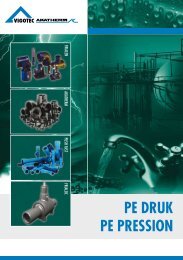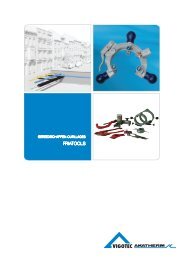Bekijk de PDF - VigotecAkatherm
Bekijk de PDF - VigotecAkatherm
Bekijk de PDF - VigotecAkatherm
You also want an ePaper? Increase the reach of your titles
YUMPU automatically turns print PDFs into web optimized ePapers that Google loves.
MONTAGERICHTLIJNEN - INSTRUCTIONS DE MONTAGE<br />
12.2.3 Vaste punten<br />
De vastpuntconstructie bij Akasison bevestiging in <strong>de</strong> horizontale leiding zorgt<br />
ervoor dat <strong>de</strong> krachten op <strong>de</strong> rail wor<strong>de</strong>n overgebracht en er een star systeem<br />
ontstaat.<br />
Vastpunt t/m diameter 160 mm<br />
Tot en met <strong>de</strong> diameter 160 mm bestaat een vastpunt uit twee elektrolasmoffen<br />
(1) en één railbeugel (2). Zie figuur 12.44.<br />
Figuur 12.44 Horizontaal vastpunt t/m 160 mm<br />
1 Art. Nr. 41xx95<br />
2 Art. Nr. 72xx10<br />
Vastpunt 200, 250 en 315 mm<br />
Vanaf <strong>de</strong> diameter 200 mm bestaat een vastpunt uit één elektrolasmof (1) en<br />
twee railbeugels (2). Voor <strong>de</strong> noodzakelijke krachtoverbrenging wor<strong>de</strong>n <strong>de</strong> bei<strong>de</strong><br />
railbeugels door een halter met elkaar verbon<strong>de</strong>n (3), zie figuur 12.45.<br />
Figuur 12.45 Horizontaal vastpunt 200, 250 en 315 mm<br />
1 Art. Nr. 41xx95<br />
2 Art. Nr. 72xx10<br />
3 Art. Nr 730010<br />
Een vastpunt wordt toegepast:<br />
-<br />
-<br />
-<br />
-<br />
Voor elk 45° T-stuk<br />
Voor elke richtingsveran<strong>de</strong>ring en aan het begin van <strong>de</strong> collector<br />
Elke 5 m (Detail C in figuur 12.46)<br />
Aan het ein<strong>de</strong> van collector (Detail A in figuur 12.46)<br />
Tussen <strong>de</strong> vaste punten komen <strong>de</strong> glijbeugels conform <strong>de</strong> beugelafstan<strong>de</strong>n.<br />
Zie figuur 12.46 <strong>de</strong>tail B.<br />
202<br />
1<br />
2<br />
12.2.3 Points fixes<br />
La fixation <strong>de</strong> l’akasison à l’ai<strong>de</strong> <strong>de</strong> points fixes dans les conduites horizontales<br />
transmet les efforts <strong>de</strong> dilatation au rail et engendre une construction rigi<strong>de</strong>.<br />
Point fixe jusqu’au diamètre 160 mm<br />
Jusqu’au diamètre 160 mm, un point fixe consiste en <strong>de</strong>ux manchons<br />
électrosoudables (1) et un collier <strong>de</strong> rail (2). Cf figure 12.44.<br />
Figure 12.44 Point fixe horizontal jusqu’au Ø 160 mm<br />
1 Art. Nr. 41xx95<br />
2 Art. Nr. 72xx10<br />
Point fixe Ø 200, 250 et 315 mm<br />
A partir du Ø200 mm, un point fixe consiste en un manchon électrosoudable (1)<br />
et <strong>de</strong>ux colliers <strong>de</strong> rail (2). Pour assurer la bonne transmission <strong>de</strong>s efforts, un<br />
tirant relie les <strong>de</strong>ux colliers ensemble (3), cf figure 12.45.<br />
Figure 12.45 Point fixe horizontal Ø 200, 250 en 315 mm<br />
1 Art. Nr. 41xx95<br />
2 Art. Nr. 72xx10<br />
3 Art. Nr 730010<br />
Il faut un point fixe:<br />
-<br />
-<br />
-<br />
-<br />
à chaque Té à 45°<br />
à chaque changement <strong>de</strong> direction et au début d’un collecteur<br />
tous les 5 m (Detail C <strong>de</strong> la figure 12.46)<br />
à la fin d’un collecteur (Detail A <strong>de</strong> la figure 12.46)<br />
Entre points fixes viennent les colliers coulissants, en respectant les distances entre<br />
colliers. Cf figure 12.46 <strong>de</strong>tail B.<br />
1<br />
2





